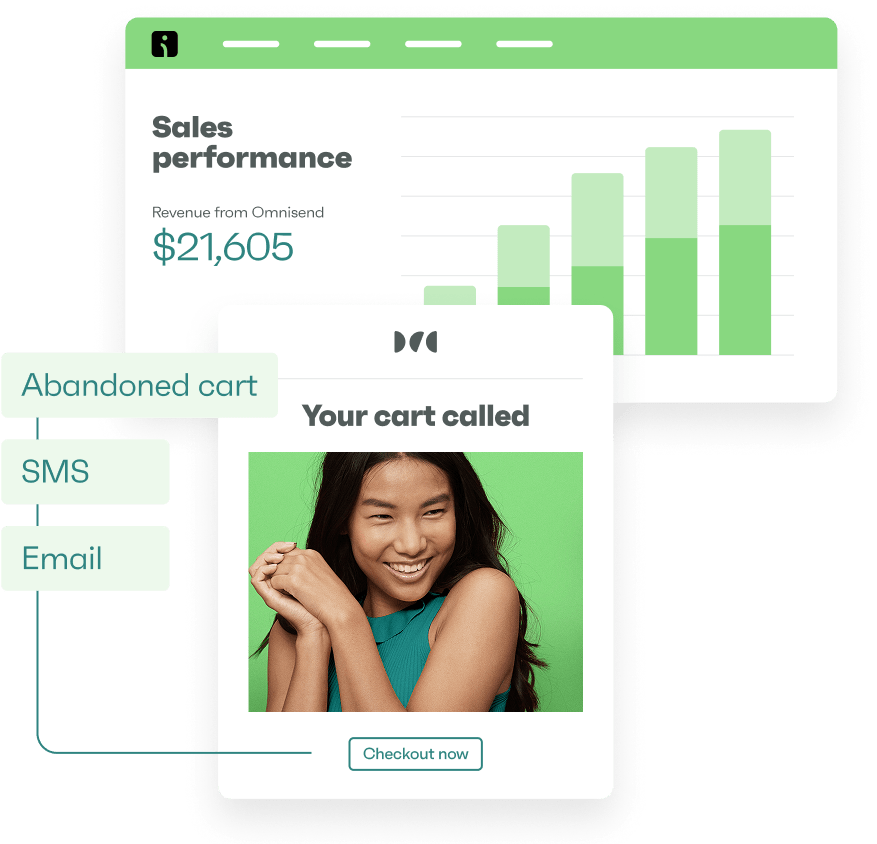Drive sales on autopilot with ecommerce-focused features
See FeaturesDropshipping vs. ecommerce comes down to how much control you want over your product, how much capital you can invest, and what you’re selling.
If you want to sell products available on AliExpress, Alibaba, and Amazon, have low capital, or don’t want to handle fulfillment, dropshipping is your strategy.
Traditional ecommerce is necessary if you manufacture, craft, or create unique products or need control over inventory and your entire customer experience.
Both strategies involve building a website and integrating an email marketing tool to grow your list and automate transactional messages. The key difference is what happens after your customer orders — will you ship the product, or will your supplier?
Join us below for an ecommerce vs. dropshipping comparison and tips to choose the best strategy for your business.
Quick sign up | No credit card required
What is dropshipping?
You sell products online through a storefront that connects to suppliers who process your orders. That connection could be through a dropshipping app or forwarding system for purchase orders.
When your customer buys from you, you buy from your supplier, who fulfills the order. They pick, package, and ship the items, giving you an inventory-free business.
It’s the cheapest ecommerce strategy for startup costs because there’s no inventory to purchase. Plus, you can integrate with platforms like DSers for free, although paid dropshipping apps unlock helpful features like tracking to create a good customer experience.
New to dropshipping? Learn how to start dropshipping with seven steps for beginners.
What is traditional ecommerce?
Traditional ecommerce means buying or making products before selling them. You store inventory, process orders, and ship packages yourself.
That hands-on approach lets you verify product quality, customize packaging, and control shipping speed. You invest capital upfront but earn higher sales margins without paying supplier markups and competing with other dropshippers.
Physical control provides competitive advantages — you can add personal touches to your customer experience, fix quality issues immediately, and adapt quickly to customer feedback.
Whether you choose a traditional ecommerce or dropshipping model, check out these 30 best ecommerce tools to drive sales in 2025.
Pros and cons of dropshipping
| Pros | Cons |
| Low startup costs with minimal initial investment | Supplier fees can eat hard into profit margins |
| No inventory management or warehouse space necessary | Limited control over product quality and shipping times |
| Location independence — run your business from anywhere | Challenging to build a unique brand with generic products |
| Easy to test new products with small sample orders | Lots of competition in most industries as the barriers to entry are low |
| Ability to easily add new products to store | |
| Simplified operations with no packing or shipping responsibilities |
Pros and cons of traditional ecommerce
| Pros | Cons |
| Potential for higher profit margins without supplier markups | Higher startup costs for inventory and storage space |
| Complete control over product quality and inventory | Ongoing warehouse and inventory management expenses |
| Ability to create unique, branded unboxing experiences | Growth requires scaling physical operations |
| Faster shipping times when fulfilling orders locally | Financial risk with unsold inventory |
| Opportunity to build exclusive product lines | |
| Direct oversight of customer experience from order to delivery |
Dropshipping vs. ecommerce – key differences
Though they might seem similar, dropshipping and traditional ecommerce represent fundamentally different operational approaches.
| Aspect | Dropshipping | Traditional ecommerce |
| Inventory | Products stored by suppliers | You purchase and warehouse stock |
| Initial investment | Often under $100 to launch | $1,000-$20,000+ for inventory and storage |
| Profit structure | 15-30% margins with supplier taking cut | 40-80% margins with fewer costs |
| Growth limitations | Supplier reliability and product quality | Capital for inventory expansion |
| Fulfillment | Supplier handles packaging and shipping | You control packing, branding, and shipping |
| Customer experience | Less control over delivery timeline | Complete oversight of unboxing experience |
| Time commitment | Focus on marketing and acquisition | Split between operations and marketing |
| Risk profile | Low financial risk, higher service risk | Higher financial exposure, lower service risk |
The big difference between ecommerce and dropshipping is that dropshipping requires no physical inventory. Your customers order through your store, you place orders with suppliers, and they fulfill the orders for your customers.
Dropshipping vs. ecommerce – which one should you choose?
Dropshipping and traditional ecommerce can earn you money online. That’s a given. But what are your goals, what products do you want to sell, what’s your risk appetite, and how hands-on do you want to be? Let’s take a look at when these strategies make sense:
When to choose dropshipping
Dropshipping is best for a low-risk, low-capital strategy. Your initial dropshipping investment can stay under $100, letting you learn how to sell online and refine your approach before going all in.
If you have a lot of capital, your product and business goals will determine whether dropshipping is a good strategy. The type of item you want to sell, its complexity, and your market positioning will guide your choice.
For instance, dropshipping could be the best strategy if you intend to sell items available on AliExpress, irrespective of your capital.
Dropshipping is also useful when testing new markets or product concepts that have yet to be proven. Selling without holding stock means you can pivot quickly if one product line fails, experimenting with multiple niches without financial catastrophe.
Choose dropshipping when:
- You want to set up a storefront and have no involvement in order fulfillment
- You want to test product ideas without risking thousands in inventory
- Your market moves fast, and products change quickly
- You’re comfortable with lower margins in exchange for minimal upfront investment
- You want to learn ecommerce without financial pressure
Fancy getting started with dropshipping? Get inspired by the 7 best dropshipping websites.
When to choose traditional ecommerce
Choose traditional ecommerce when your product requires a unique, high-touch approach that mass-market dropshipping can’t match.
You’ll have direct oversight over product quality and customer experience, allowing you to resolve manufacturing issues quickly and innovate your product based on customer feedback.
Investing in inventory lets you design custom packaging, guarantee product quality, and create rapid shipping that builds customer loyalty. Your margins grow as you cut out supplier middlemen, giving you more revenue to reinvest in your brand’s growth.
When you own your entire product ecosystem, more advantages emerge. Your competitive edge includes specialized products, premium positioning, and direct customer relationships, things that dropshipping brands can’t match.
Choose traditional ecommerce when:
- Your brand requires absolute control over product quality and experience
- You’ve developed a unique product that needs careful, hands-on management
- Your margins can support inventory investment
- Your competitors are dropshippers with low-quality customer experiences (there’s an opportunity to dominate them)
- Building a premium, consistent brand matters more than rapid scaling
If traditional ecommerce sounds perfect for your business, discover the 25 best ecommerce websites of 2025.
When to combine dropshipping and traditional ecommerce
You can dropship to validate market demand before holding inventory or combine both approaches in a hybrid ecommerce model.
For example, you might maintain a direct stock of protein powder but dropship shakers, accessories, and workout gear.
That hybrid approach is perfect if you want to sell multiple product lines without a massive upfront investment. Once you confirm demand for products you dropship, consider purchasing inventory for direct fulfillment to provide a consistent customer experience.
A hybrid approach works best when:
- You have a core product line and want to expand into accessories and merchandise without holding extra inventory (pivot to dropshipping)
- Your visitors are repeatedly searching your store for products you don’t offer, and you need a quick way to satisfy them (pivot to dropshipping)
- Your dropshipping suppliers prove unreliable for some products, and you need to provide a better customer experience (pivot to traditional ecommerce)
How to drive sales for your dropshipping or ecommerce store with email marketing
Launching your online store is just the beginning. The next challenge is mastering marketing strategies that transform browsers into buyers and one-time customers into brand advocates.
Email marketing can help achieve that, whether you choose ecommerce vs. dropshipping or vice versa. You’ll own your list and have predictable marketing costs since email platforms charge by either contact list size or the number of emails sent.
Follow these tips to build a sales-winning email marketing strategy:
Build your email list
You’ll capture customer email addresses when they place orders, but not everyone will purchase the first time they visit your site. However, they will likely sign up for your email list in return for a healthy discount on their next order.
You can provide that incentive with a popup form, and there are a few types:
- Exit-intent popups
- Time-based popups
- Wheel of Fortune signup forms
- Embedded forms in product pages
- Checkout email collection fields
Design your popups with clear, single-field email capture and an irresistible offer. Promise a 10% discount, free shipping, or exclusive content that makes signing up a no-brainer.
Here’s an example of a Wheel of Fortune popup created with Omnisend:
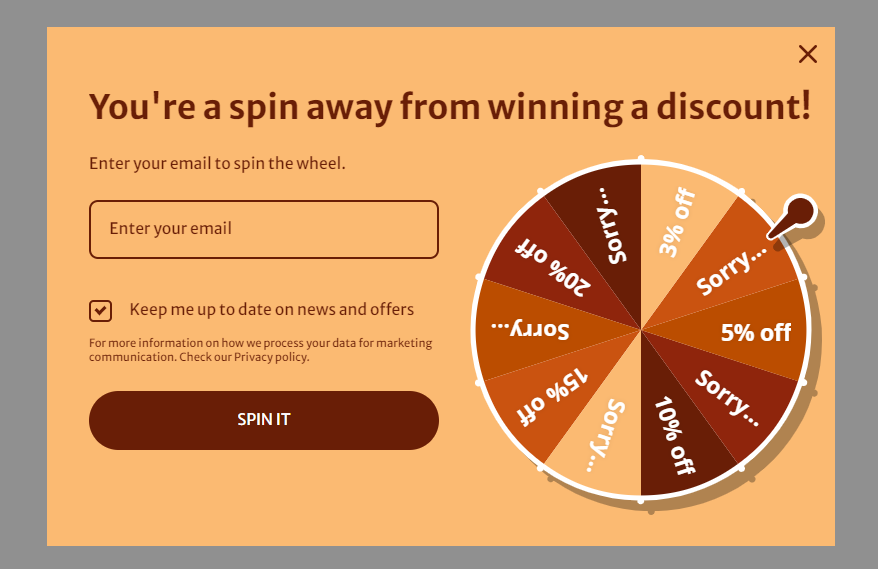
Once you capture your customer’s email, follow up with an automated welcome email sequence that delivers the promised value. Your first email should include the discount code or free resource, setting the stage for future engagement.
Segment your contacts
Create segments that allow you to send precise, relevant messages to different customer types instead of blasting everyone with the same content.
Build segments using these critical criteria:
- Purchase frequency
- Total customer value
- Product categories bought
- Engagement level
- Geographic location
- First-time vs. repeat customers
Create advanced segments that go beyond basic demographics. For instance, you could group high-value customers (purchase amount over $100) who haven’t purchased in the last 90 days.
Omnisend lets you split customers into groups based on what they buy, where they click, how they engage, and when they shop. You can use pre-built segments or start from scratch with our segment workflow editor:
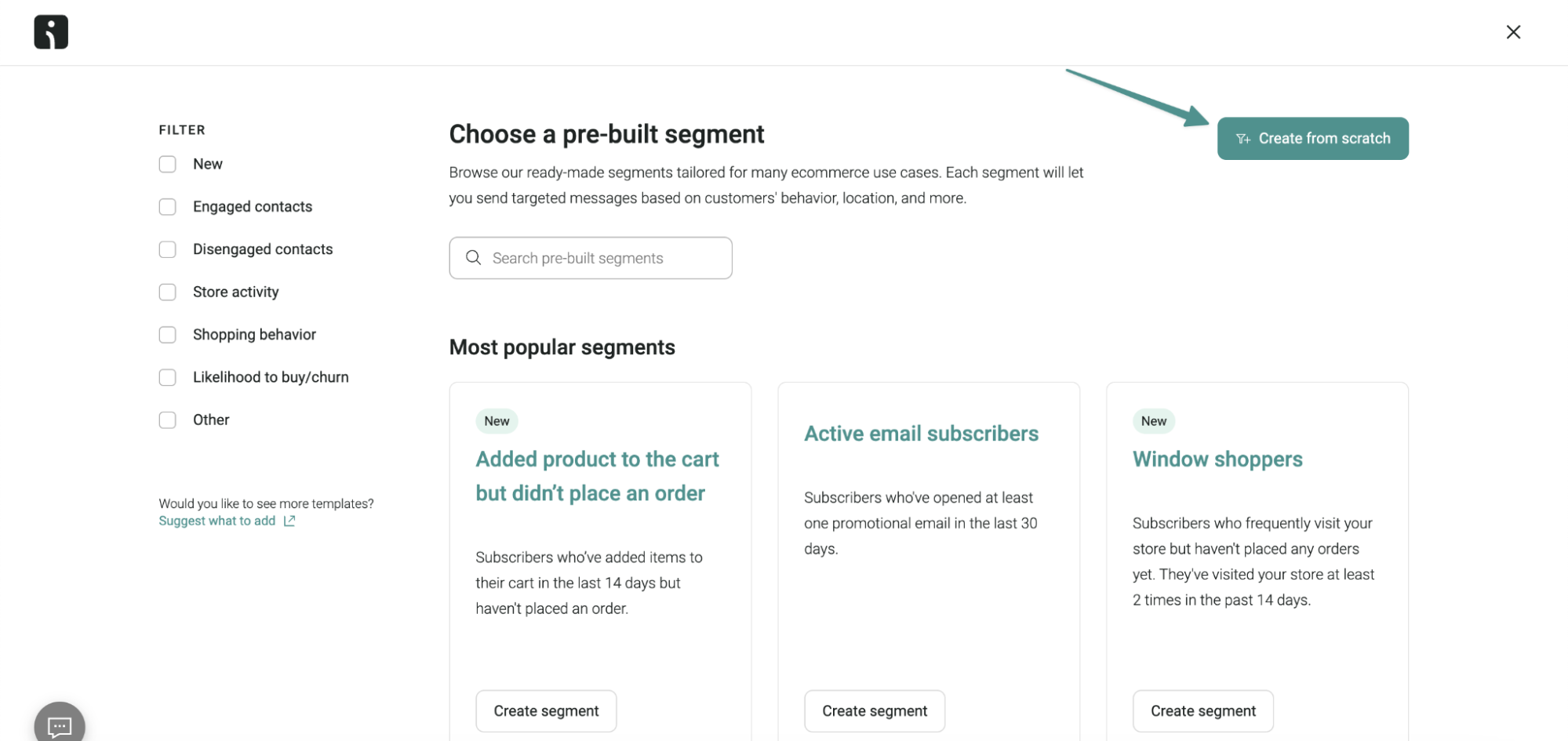
Create automated email workflows
Set up automated email sequences that run without your constant intervention. Build a welcome workflow that triggers after someone subscribes, sending emails introducing your brand and offering an initial discount.
Create key automated workflows:
- Welcome series for new subscribers
- Abandoned cart recovery
- Post-purchase follow-up
- Customer reactivation
- Birthday or anniversary promotions
Design each workflow to move customers through a specific journey. Your abandoned cart workflow could send a first reminder within an hour, a second with a discount after 24 hours, and a final urgency-driven message after 48 hours.
Omnisend has pre-built automations for all the workflows above and lets you add unlimited filters to deliver messages at the right moment:
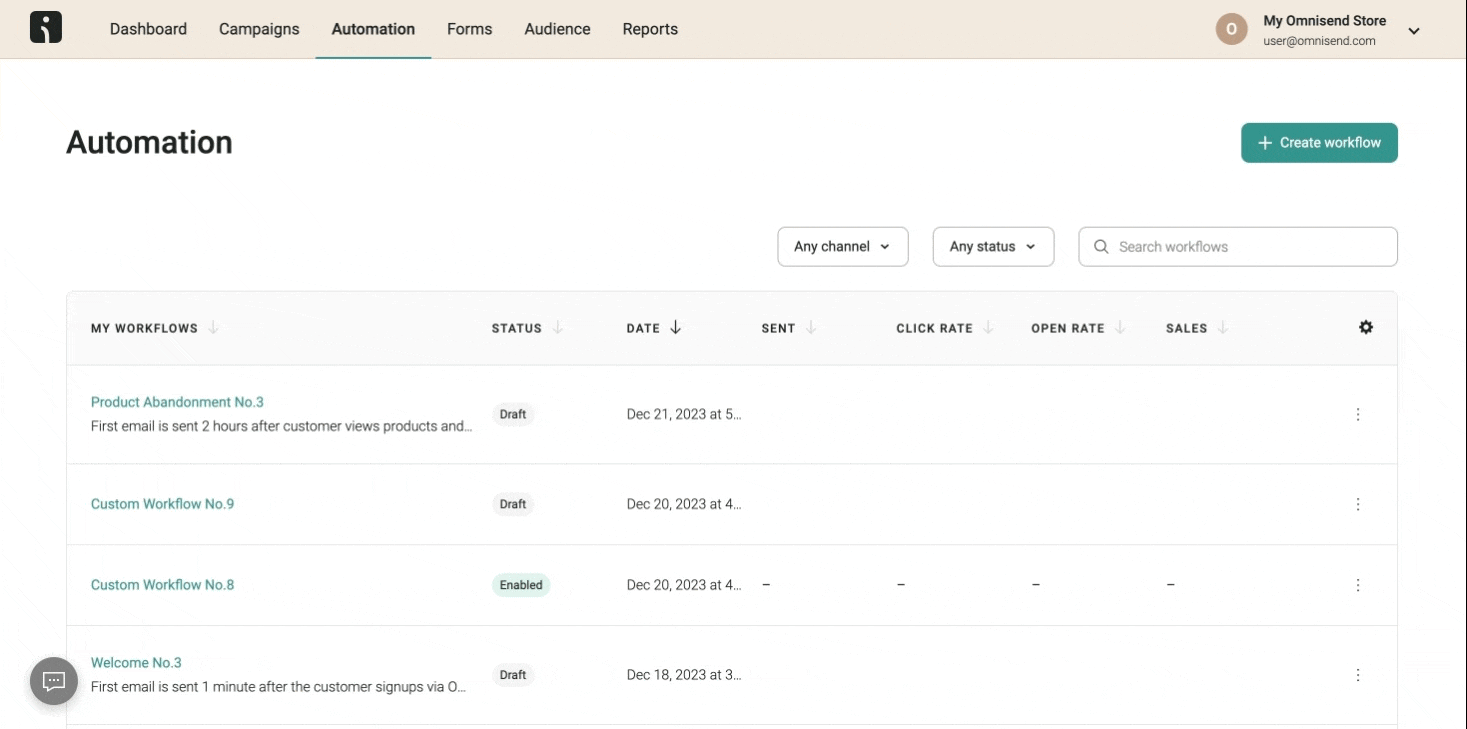
Use SMS and omnichannel marketing
Use SMS marketing for urgent, time-sensitive messages that demand immediate attention, such as confirming an account. Combine with email and push notifications to reach customers via their preferred contact methods.
Consider testing different channels to see what works:
- SMS for flash sales and time-limited offers
- Push notifications for product restocks
- SMS for order confirmations and shipping updates
- Emails for promotional messages and abandoned carts
This video provides a thorough introduction to SMS marketing:
Omnisend supports SMS automations and campaigns, letting you create marketing and transactional messages for your customers:
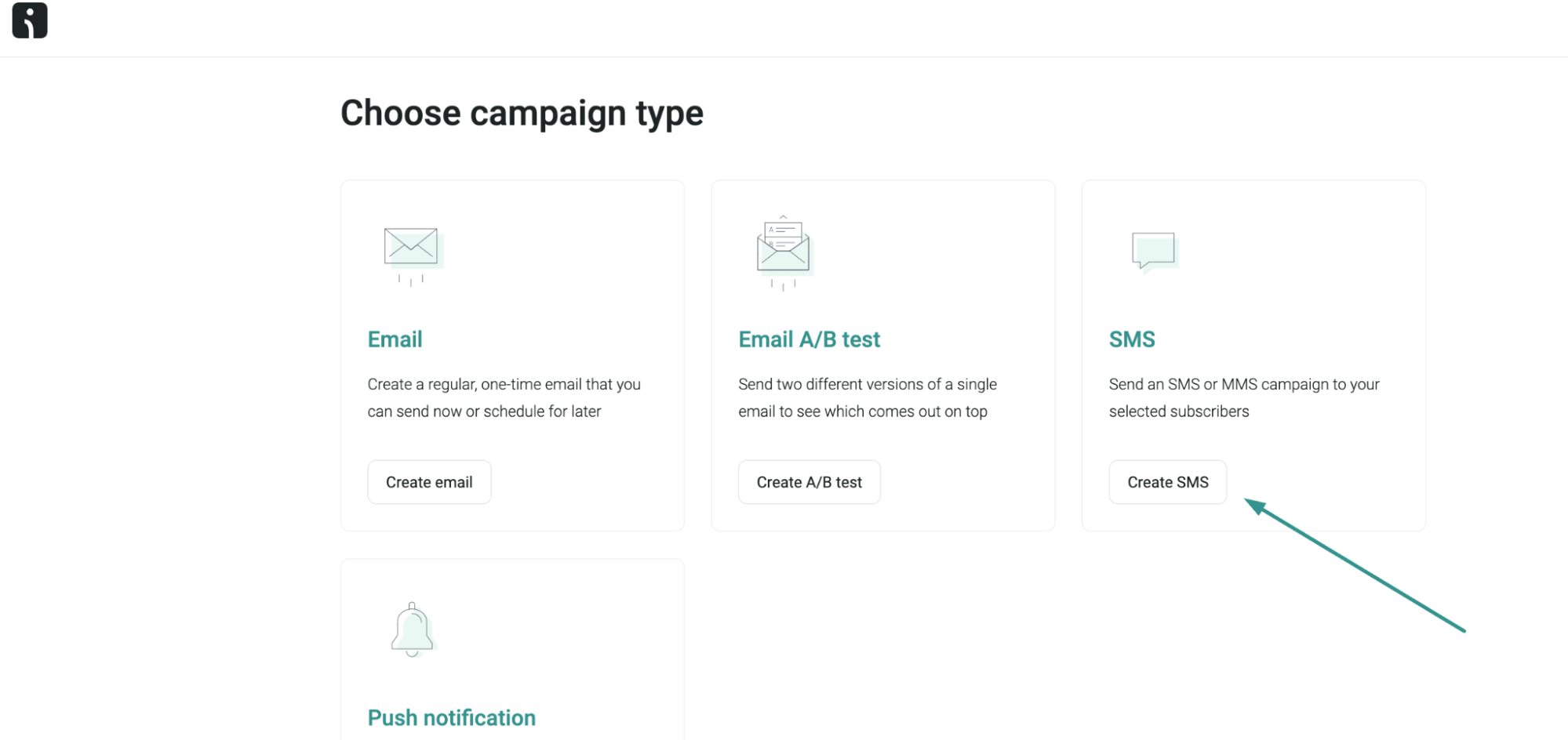
Enflow Digital transformed a struggling ecommerce brand’s marketing by reimagining segmentation, automations, and campaigns with Omnisend, boosting monthly revenue from $150K to $250K.
Read the case study here.
Wrap up
The ecommerce vs. dropshipping decision comes down to your priorities. Need minimal investment with location freedom? Dropshipping gives you that flexibility. Want control over product quality and higher margins? Traditional ecommerce is your path.
Just remember that your business model isn’t a permanent decision. You can start with what works now, then adapt. Many successful stores begin dropshipping, identify their bestsellers, and then take control of fulfillment for those products to boost margins.
Dropshipping vs. ecommerce: FAQs
No. Dropshipping is one fulfillment method within ecommerce where suppliers handle inventory and shipping, and you manage the storefront and marketing.
That depends on your profit margin and sales volume. For instance, if you dropship high-ticket items like gold jewelry with a 150% markup, your profit margins will be higher than the average jewelry store that stocks inventory.
Yes. Test with dropshipping, then stock winning products to control customer service and shipping. You’ll also achieve better margins.
Email makes you money regardless of the fulfillment model by recovering abandoned carts, encouraging repeat purchases, and building customer relationships. Your automated sequences work 24/7 while you focus on other aspects of your business.
TABLE OF CONTENTS
TABLE OF CONTENTS


No fluff, no spam, no corporate filler. Just a friendly letter, twice a month.

 OFFER
OFFER







